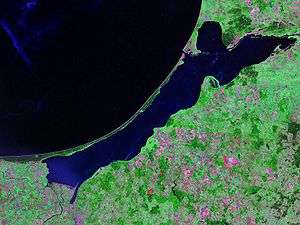Haff disease
| Haff disease | |
|---|---|
 | |
| Satellite photo of the Vistula Lagoon, formerly known as Frisches Haff. Haff disease was first described in the location of Königsberg.[1] | |
| Classification and external resources | |
| ICD-9-CM | 985.1 |
| DiseasesDB | 33568 |
Haff disease (German: Haffkrankheit) is the development of rhabdomyolysis (swelling and breakdown of skeletal muscle, with a risk of acute kidney failure) within 24 hours of ingesting fish.[2]
History
It was first described in 1924 in the vicinity of Königsberg, Germany (now Kaliningrad, Russia) on the Baltic coast, in people staying around the northern part of the Vistula Lagoon (German: Frisches Haff).[3]
Over the subsequent fifteen years, about 1000 cases were reported in people, birds and cats, usually in the summer and fall, and a link was made with the consumption of fish (burbot, eel and pike).[2] Since that time, only occasional reports have appeared of the condition, mostly from the Soviet Union and Germany.[2]
In 1997, six cases of Haff disease were reported in California and Missouri, all after the consumption of buffalo fish (Ictiobus cyprinellus).[4]
In July and August 2010, dozens of people contracted rhabdomyolysis after eating Procambarus clarkii in Nanjing, China. A month later, the Chinese authorities claimed they were victims of Haff disease.[5]
An outbreak was reported in Brooklyn, New York on 18 November 2011, when two household members were stricken by the syndrome after eating buffalo fish.[6] On February 4, 2014 two cases of Haff Disease were reported in Cook County, Illinois following the consumption of buffalo fish.[7]
Poison
The exact nature of the poison is still unclear. In the U.S. outbreak, the source of the fish was traced by the Centers for Disease Control and Prevention, and studies of other fish from the same sources showed a hexane-soluble (and hence non-polar lipid) substance that induced similar symptoms in mice; other food-borne poisons commonly found in fish could not be detected.[2] It cannot be inactivated by cooking, as all six CDC cases had consumed cooked or fried fish.[2] Palytoxin has been proposed as a disease model.[8] It has also been suggested that the toxin may have thiaminase activity (i.e. it degrades thiamine, also known as vitamin B1).[9]
References
- ↑ "Haff disease" at Dorland's Medical Dictionary
- 1 2 3 4 5 Buchholz U, Mouzin E, Dickey R, Moolenaar R, Sass N, Mascola L (2000). "Haff disease: from the Baltic Sea to the U.S. shore". Emerging Infect. Dis. 6 (2): 192–5. doi:10.3201/eid0602.000215. PMC 2640861
 . PMID 10756156.
. PMID 10756156. - ↑ Lentz O (1925). "Über die Haffkrankheit". Med Klin (in German). 1: 4–8.
- ↑ Centers for Disease Control and Prevention (CDC) (1998). "Haff disease associated with eating buffalo fish--United States, 1997". MMWR Morb. Mortal. Wkly. Rep. 47 (50): 1091–3. PMID 9883771.
- ↑ 病征确由龙虾引发 与"Haff病"基本一致
- ↑ https://a816- health29ssl.nyc.gov/sites/NYCHAN/Lists/AlertUpdateAdvisoryDocuments/2011%20DOHMH%20Haff%20Disease%20advisory.pdf (sign in may be required)
- ↑ State of Illinois Department of Public Health (4 February 2014). "Illinois Department of Public Health Warns of Buffalo Fish Causing Illness". Press Release. Retrieved 5 February 2014.
- ↑ Langley RL, Bobbitt WH (2003). "Haff disease after eating salmon". South. Med. J. 100 (11): 1147–50. doi:10.1097/SMJ.0b013e3181583673. PMID 17984750.
- ↑ Kumagai, Michio (2003). Freshwater Management: Global Versus Local Perspectives. Berlin: Springer. p. 88. ISBN 4-431-00488-2.
Secondary sources
- Jürgen W. Schmidt: Die "Haffkrankheit" in Ostpreussen im Herbst 1932, in: Preussenland - Mitteilungen der Historischen Kommission für Ost- und Westpreussische Landesforschung und aus dem Geheimen Staatsarchiv Preussischer Kulturbesitz Heft 2/2009 (47. Jg.) pp. 57–60